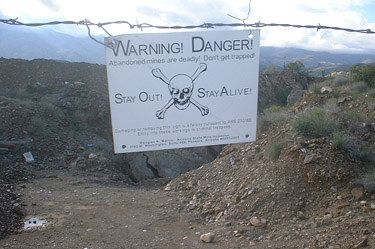Extreme conservation: constructing new habitat in ecological wastelands
 Plants,
Plants,  Restoration
Restoration  Danger sign at entrance to an abandoned mine in Arizona. Credit, Paul Fitzhugh.For severely degraded areas like abandoned mines and industrial wastelands, restoring the landscape back to its former natural state can be extremely difficult.
Danger sign at entrance to an abandoned mine in Arizona. Credit, Paul Fitzhugh.For severely degraded areas like abandoned mines and industrial wastelands, restoring the landscape back to its former natural state can be extremely difficult.
Frequently, these sites have been so dramatically altered that restoration requires intensive efforts like the remediation of pollution, landscape reconfiguration through geoengineering, and the introduction of new topsoil, subsoil, and plants.
Given that these methods can be extremely expensive and still may not achieve success, researchers have proposed an alternative approach that involves constructing new ecosystems that are adapted to the extreme environments of these sites.
Paul Richardson from the University of Guelph and fellow scientists tested the approach on the floor of a long-abandoned limestone quarry in Ontario where only sparse vegetation had been growing. They published their findings in the journal Ecological Applications.
The researchers were able to successfully establish plant species found on natural limestone pavements called alvars - a rare ecosystem that occurs naturally in other parts of the Great Lakes region.
With few inputs and little effort, the researchers were able to double species richness after three years and establish plant communities that resembled natural alvar systems.
The idea behind the approach is that for many degraded sites, analogous ecosystems with similar physical conditions exist naturally, and the species inhabiting these extreme environments have adapted over time to these conditions.
So even though these ecosystems would not have historically occurred at the degraded sites, constructing them there would be more likely to establish a highly functional biotic community and would cost much less than trying to restore what existed pre-disturbance.
Another benefit is that this type of habitat construction can help conserve the biodiversity of threatened ecosystems. The species inhabiting naturally occurring extreme environments like alvars are generally highly specialized to tolerate the harsh conditions and therefore are found in few other locations.
In their experiment, the scientists were able to establish regionally restricted and threatened species like Iris lacustris, Solidago ptarmicoides, and Liatris cylindracea.
Amazingly, once planted, these species were able to establish despite the harsh condition of the quarry floor where temperatures can reach 68 degrees C in hot weather, and normal weather patterns can lead to flooding, prolonged inundation, and intense drought.
The authors conclude, " sites that are extremely difficult to restore because of stringent abiotic filters may be successfully and efficiently colonized by species that naturally fit the ‘‘mesh’’ of such filters."
Furthermore, establishing degraded-state analogous plant communities "can promote ex-situ biodiversity conservation within difficult to restore anthropogenic wastelands."
--by Rob Goldstein
Richardson, P., Lundholm, J., & Larson, D. (2010). Natural analogues of degraded ecosystems enhance conservation and reconstruction in extreme environments Ecological Applications, 20 (3), 728-740 DOI: 10.1890/08-1092.1




Reader Comments